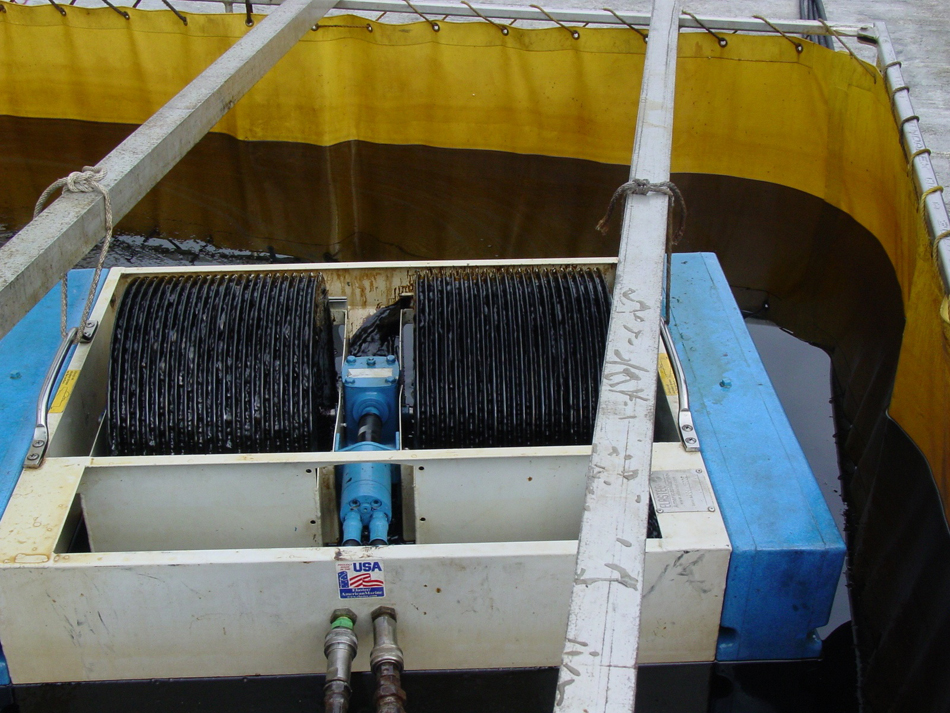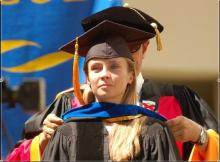

Among the many tools being used to clean up the country's worst environmental disaster –– the Deepwater Horizon platform explosion and oil spill in the Gulf of Mexico –– is a new device called the Groovy Drum Skimmer. Designed to scoop oil from the surface of the ocean, the skimmer is the brainchild of former UC Santa Barbara graduate student Victoria Broje.
While earning her Ph.D. from UCSB's Bren School of Environmental Science & Management in 2002-06, Broje came up with the idea for the skimmer after conducting research on how to make these oil-collecting devices more effective. Her new design, which features hydrocarbon-based rubber and a drum with a triangular-grooved pattern, proved to be as much as 300 percent more efficient than previous skimmers.
"When I came up with the idea, my professor, Arturo Keller, was very supportive of making sure that this technology would find a real-life application," Broje said. "Several of his students helped me with additional testing of the technology at the Bren School laboratory. This lab was specifically modified with custom-made equipment to accommodate various tests."
After testing and perfecting the skimmer design, Broje turned to Sherylle Mills Englander, director of UCSB's Office of Technology & Industry Alliances, who helped the young inventor through a maze of patent and licensing paperwork. "She explained what specific steps I needed to take and how they would help me," Broje said. "I told her how I envisioned this technology would work and she did the rest: translating the idea into legal language, checking previously patented technologies, filling out the patent, conducting ‘terms of use' negotiations with potential end-users, and eventually licensing the technology to the selected manufacturer."
Englander's office focuses on building and keeping track of UCSB's portfolio of active inventions and patents, as part of the University of California's technology transfer program. In fiscal 2009, UCSB's portfolio included 92 inventions, four start-up companies, and income from royalties and fees of more than $2.7 million. According to Englander, four to seven new companies based on UCSB research are formed every year. In addition, 66 companies on four continents (30 in California) currently are using technologies developed at UCSB.
In Broje's case, Englander helped her choose the company that would produce the skimmer –– Elastec/American Marine, the country's leading manufacturer of oil spill recovery equipment. "Several companies came up with an interest in commercializing this skimmer," Englander said. "American Elastec was the one we chose to work with. This was an example of how, by getting a patent to prevent competitors from copying this skimmer, American Elastec felt safe in creating the investment needed to take this prototype and put it into a large-scale commercial product. And that's how it wound up in the Gulf. The company has at least two in the Gulf now."
Englander is proud of Broje and pleased that her office was able to help turn this graduate student's dream into a reality. "This is a perfect example of how our university uses intellectual property to facilitate the adoption of scientific discoveries," Englander said. "We use intellectual property when we need to provide incentive for a company to get out the product. We're doing it for the public good."
Broje said the idea-to-product process at UCSB was smooth, efficient, and extremely helpful. "I think it is invaluable that the university has experienced people that can take the legal and administrative burden off the shoulders of researchers, and allow them to focus on what they do best –– science," Broje said. "I would never have attempted to patent this technology myself. UCSB made it very easy. You just tell them what idea you have, and they do the rest. I wish everything in life worked that easy."
Another factor in her success was UCSB's facilitation of interdisciplinary collaboration. The Bren School, according to Broje, was a perfect example.
"Great discoveries can be made and innovative solutions found when researchers from different disciplines come together," Broje said. "The research I did would not fit well in any one department. It was a project that combined environmental science, petroleum chemistry, fluid material science, and engineering. Bren School allowed me to tap into resources and expertise of other departments. The professors from all of these departments were very willing to share their expertise and explore implementation of their knowledge."
Related Links



